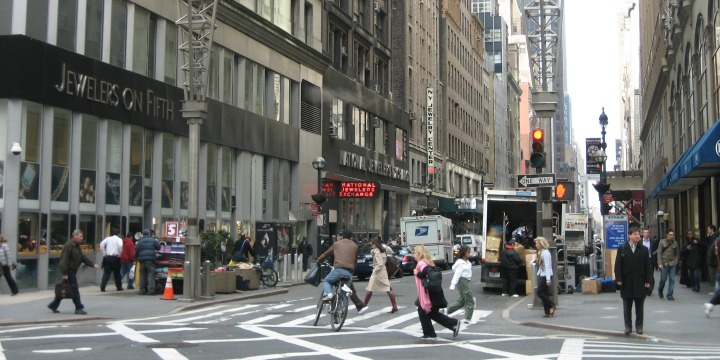The History of Antisemitism in New York
 by Harold Brackman
by Harold Brackman
America’s long suspicion of New York City as a hotbed of irreligion, immoral culture, and the Jewish community there can obstruct the fact that Jews haven’t always had an easy time in New York.
In 1654, 23 Jewish refugees from Portuguese Brazil arrived in New Amsterdam, only to receive a frigid reception from Governor Peter Stuyvesant. A Calvinist minister’s son, Stuyvesant preferred African slaves to “unbelieving Jews.” The story goes that these Jewish founding fathers — never giving up — were eventually granted the rights to reside, work, and worship there.
This inspiring tale is a bit of an oversimplification. The first Jew to arrive in New York, Jacob Barsimon, came as part of a commercial party from Old Amsterdam. Barsimon’s special mission was to determine the prospects for Jewish settlement in North America.
Second, the success in defeating bigoted Governor Stuyvesant was not just a tribute to Jewish perseverance or a reflection of the power of pluralism in tiny New Amsterdam, which already in 1646 was made up of 400 or 500 men “of different sects and 56 nations.” It was the critical result of the Jews’ trans-Atlantic petition to the governing Dutch West India Company. Successfully pleading that they fought for Holland in its war against Portugal in Brazil, they also mentioned the role of Dutch Jews as benefactors of the old-world company.
Amsterdam’s tiny Jewish community never controlled the Dutch West India Company, as antisemites down to Louis Farrakhan have claimed. Yet Holland viewed itself as involved in a global struggle — a veritable “clash of civilizations” — in which an intrepid Protestant Dutch “David” needed all the help he could get, including from a handful of Jewish merchants, against Imperial Spain’s Catholic “Goliath.”
In colonial New York, Protestant England increasingly was pitted against Catholic France. Jews profited from popular anti-Catholicism, which was far stronger than antisemitism. For example, in Boston, the descendants of Puritans burned effigies not of Jews — but of the Pope.
Third, Jewish achievement of religious freedom was an arduous struggle. The directors of the Dutch West India Company refused to grant Jews in New Amsterdam the same right of public worship as in Old Amsterdam. Instead, they were supposed to “build their houses close together” in order to worship in private. Congregation Shearith Israel was established in 1654, but not until 1730 did it build its first synagogue on Mill Street.
During the American Revolution, Jews throughout the colonies fought for independence. But this did not prevent Pennsylvania’s state constitution of 1776 from disenfranchising Jews. In 1777, New York State’s constitution began the movement to remove political prohibitions against the Jews, which was not completed until Maryland’s “Jew Bill” of 1826. In 1790, President Washington wrote to the Jews of Newport, commending religious “tolerance” as part of “inherent natural rights.” Nevertheless, anti-Jewish prejudice was still prevalent, and it never truly faded away.
From Stuyvesant’s Dutch colony, to the Christian Front before World War II, to Crown Heights thugs today, New York has never lacked bigots shouting: “No Jews wanted here.”
Harold Brackman is coauthor with Ephraim Isaac of From Abraham to Obama: A History of Jews, Africans, and African Americans (Africa World Press. 2015).
 Israeli Hostage Hersh Goldberg-Polin Seen Alive in a New Hamas Video
Israeli Hostage Hersh Goldberg-Polin Seen Alive in a New Hamas Video Palestinian Prime Minister Announces New Reform Package
Palestinian Prime Minister Announces New Reform Package France: Man Suspected of Abducting, Raping Jewish Woman ‘to Avenge Palestine’
France: Man Suspected of Abducting, Raping Jewish Woman ‘to Avenge Palestine’ Israel Intensifies Strikes Across Gaza, Orders New Evacuations in North
Israel Intensifies Strikes Across Gaza, Orders New Evacuations in North Iran Threatens to Annihilate Israel Should It Launch a Major Attack
Iran Threatens to Annihilate Israel Should It Launch a Major Attack ‘Completely Baseless’: Reports of Mass Graves at Gaza Hospitals are False, IDF Says
‘Completely Baseless’: Reports of Mass Graves at Gaza Hospitals are False, IDF Says Columbia University Shutters Campus as Jews Fear for Safety, Critics Call for President to Resign
Columbia University Shutters Campus as Jews Fear for Safety, Critics Call for President to Resign ‘Hamas, We Love You!’ A List of the Chants, Statements From Columbia University’s ‘Gaza Solidarity Encampment’
‘Hamas, We Love You!’ A List of the Chants, Statements From Columbia University’s ‘Gaza Solidarity Encampment’ ‘Useless Pigs’: Anti-Israel Demonstrations Rage at Yale University, Forcing Police Intervention
‘Useless Pigs’: Anti-Israel Demonstrations Rage at Yale University, Forcing Police Intervention Anti-Israel Protesters Interrupt Chelsea Handler Comedy Show Because of Her Support for Jewish State
Anti-Israel Protesters Interrupt Chelsea Handler Comedy Show Because of Her Support for Jewish State




 France: Man Suspected of Abducting, Raping Jewish Woman ‘to Avenge Palestine’
France: Man Suspected of Abducting, Raping Jewish Woman ‘to Avenge Palestine’ Palestinian Prime Minister Announces New Reform Package
Palestinian Prime Minister Announces New Reform Package Israeli Hostage Hersh Goldberg-Polin Seen Alive in a New Hamas Video
Israeli Hostage Hersh Goldberg-Polin Seen Alive in a New Hamas Video